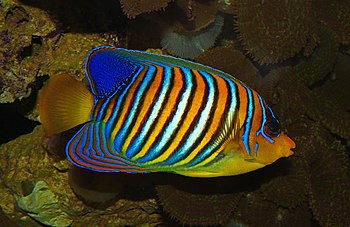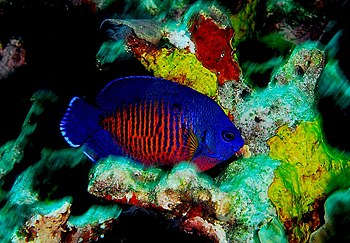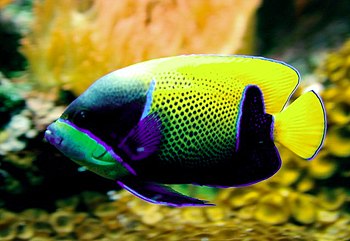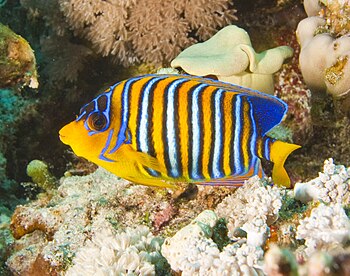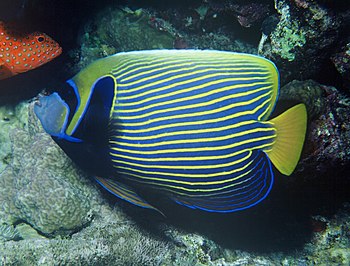Among the most spectacularly colored dwarf angelfish, the flame angelfish has become the most recognizable and the most popular member of the genus centropyge. Almost everyone in the marine aquarium hobby has at one time either owned a flame angel or at least considered getting one. A true testament to the beauty this angel possesses.
 |
| Flame angel, Centropyge loricula (Photo credit: Wikipedia) |
The genus centropyge contains 33 species that have been found thus far, making it the largest genus within the marine angelfish complex (Pomacanthidae). Our fish of interest goes by the scientific name
Centropyge Loriculus. Its common name is the
flame angelfish, so named because it is colored a bright red-orange with vertical black lines down its body. The tips of its anal and dorsal fins are accentuated with neon blue patches.
The flame angel is a little on the high side in terms of price so expect to pay between $ 40 and $ 50 US dollars for a specimen. While this may seem like a lot for an ornamental fish, it pales in comparison with rarer angelfish such as the golden angelfish. Considering the effect it has on most onlookers I’d say the price is a steal.
While commonly thought to hail from Hawaii, they are actually collected around the Marshall and Christmas Islands instead. True Hawaiian flame angelfish are very rare and are said to have a very specific coloration. They are uniformly red without any orange throughout their bodies and their black vertical lines are always thin.
As with all members of the genus centropyge this angelfish can be aggressive towards other tank mates. They are particularly hostile towards members of the same species. Putting two
flame angelfish together in a small tank is generally a bad idea. The same goes for housing two members of the same genus together. Such an endeavor should only be attempted if the marine aquarium in question is large enough, 75 gallons or larger.
The
flame angelfish should be kept in an aquarium no less than 50 gallons. Ideally, you’d want something like a 75 gallon or larger aquarium for them. The added space keeps issues stemming from territory to a minimum. This is assuming the tank isn’t chock full of fish in the first place. They require caves and holes throughout the rock scape so your live rock arrangement should reflect this.
Like all members of the genus centropyge, the flame angelfish has been known to nip on corals in a reef aquarium. There is no telling when such behavior will happen. I’ve heard stories of flame angels that have never bothered corals for years only to begin sampling them overnight. This is how it is with all dwarf angelfish. No exceptions. Unfortunately, once they start nipping they usually don’t stop.
Flame angelfish are grazers in the wild. They constantly pick at the substrate and rocks that surround their territory. Their food items mainly consist of tiny crustaceans and algae.
Ensure they are given a varied diet within a marine aquarium. Provide a good mix of algae based foods along with meaty foods. Nori, spirulina, frozen mysis shrimp and other meaty or algae gel cubes should be part of their everyday diet. A good dry food for flame angels is new life spectrum, formula one and formula two pellets. A great food that contains everything they find in the wild is the pygmy angel formula gel cubes by ocean nutrition. These only come in frozen form i believe.
In the wild, flame angelfish form harems, a single male will dominate up to 7 females. Each female maintains a separate territory within the male's territory. Every evening the male approaches each female in his harem until he chooses to mate with one of them. He then assumes courting behavior. Fins are flared, he darts around the female in circles and assumes mating colors.
Courting ensures anywhere from 5 to 15 minutes until they finally spawn. The male nudges the female up into the water column until they are perfectly positioned to release eggs and sperm at the same time. The actual mating process takes no longer than half a second. Having mated, they disappear into the rocks.
While there have been many cases of flame angel pairs spawning in the home aquaria, there have been no cases of their larvae being raised to adulthood. Dwarf angelfish have only been successfully raised on a commercial level by companies with a lot of money backing them. And even then, success came not more than 7 years ago.
The biggest breakthrough in angelfish breeding happened in Hawaii around 2002. It was found that the key ingredient to raising dwarf angelfish larvae was in finding an appropriate food for them. The food item had to fulfill 3 criteria. It had to be small enough for the larvae to eat, it had to be nutritious enough for them and it had to move in a way that elicited a natural feeding response from the larvae.
Frank Baensch of Reef Culture Technologies along with three others collaborated to find this food, and they were successful. What followed was the captive breeding of not just the flame angelfish but of rarer species such as the bandit angelfish, Colin's angelfish, and the Japanese pygmy angelfish. All very expensive fishes in the hobby. The breakthrough food is reputed to be an undisclosed copepod nauplii.
Such success has not been seen by hobbyists or even small scale breeders of marine fish. Baby brine shrimp and rotifers are the mainstays of home breeding but both of them do not seem to elicit a feeding response from dwarf angelfish larvae. As a result of the larvae usually, starve to death. So the key is finding an easily bred food that would work on this species. Until that time comes we are left with buying wild caught flame angelfish and even the occasional captive bred ones.
